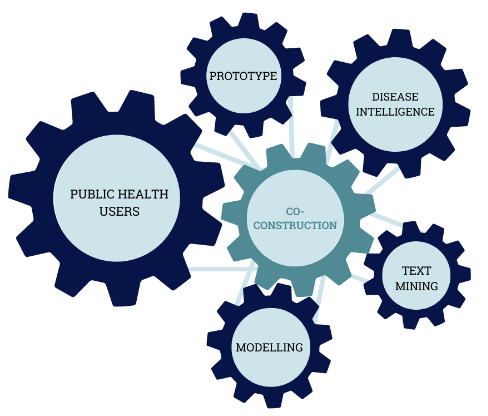MOOD Epidemic Intelligence Platform: modules & components
The MOOD platform aims to increase the operational abilities of epidemic intelligence and surveillance teams across national public and animal health agencies to better detect, monitor and assess emerging infectious diseases of known or unknown origin, and antimicrobial resistant pathogens.
Modules of the MOOD Platform

Module (1) provides users with a one-stop “shop” for the visualization and download of relevant covariates relative to the MOOD model diseases and, more generally, to infectious disease emergence in support of risk assessment and modeling. Users can save and store search queries, selected layers, locations, and other spatial and temporal information.

Module (2) provides users with a visualization and the possibility to download data on disease outbreaks, extracted from online media news using text mining with Padi-web, an online media monitoring tool. Padi-web screens Google news in multiple languages and geographical regions and is currently used by the French epidemic intelligence team in animal health, as a key data source.

The disease-specific module (3) provides users with risk maps and other modelled outputs, aiming at highlighting areas suitable for the occurrence of (mainly) HPAI, WNV and TBE in animals and humans, to support improved disease detection, monitoring and surveillance.
Component: Case Study Diseases
MOOD co-conception for sustainable innovations in Epidemic Intelligence
What is MOOD doing?
The MOOD project aims to develop innovative tools and services in a single platform for the early detection, assessment, and monitoring of current and potential infectious diseases threats in Europe in a context of global change and a profusion of big data in our professional routines. In order to reach this goal, MOOD is crafting a novel Epidemic Intelligence platform involving epidemiologists, data scientists, developers and social scientists. The user-driven development of the tools and services ensures their effective integration by Public Health & Animal Health (PH/AH) practitioners and surveillance officers into their epidemic intelligence/ surveillance systems and mitigation strategies.
Why a new Epidemic Intelligence platform?
Epidemic Intelligence (EI) practitioners face an overwhelming amount of data from multiple sources, formats and platforms. In addition, they have difficulties to collect timely consolidated datasets on disease outbreaks, to process these data easily in order to proceed to rapid risk assessment in a One Health perspective. The MOOD platform integrates all spatial layers of disease outbreak and surveillance data, drivers of emergence and data processing methods (e.g. for data reduction, upscaling and downscaling, normalization) and (outputs from) spatial and mechanistic modelling. Using the platform, EI practitioners will have access to documented timely high-resolution estimates of the risk of disease occurrence, introduction and spread. This will significantly increase their capacity for the early detection, monitoring, and assessment of emerging infectious disease threat in a changing environment.
For whom is MOOD intended?
MOOD innovations target EI practitioners from international and national PH/AH agencies in Europe (and beyond) willing to better detect, monitor and assess the risk of emerging infectious diseases and/or more specifically of West Nile Virus, (WNV) Tick-borne Encephalitis (TBE), Highly-Pathogenic Avian Influenza (HPAI), Chikungunya-Dengue-Zika virus (CHI-DEN-ZI), Tularemia-Leptospirosis (TU-LEPT), Disease-X and Antimicrobial Resistance (AMR). The platform includes potential disease drivers and impacts of climate change on disease emergence in monitoring, preparedness and risk assessment of emerging infectious diseases.
What does the platform co-creation process look like?

The co-creation consists of rounds of demonstrations, workshops and meetings between MOOD developers and the end-users from PH/AH agencies. These rounds are moderated by case studies facilitators, researchers & experts for the MOOD model disease, together with the MOOD developers (Avia-GIS). MOOD developers PH/VH practitioners will visualize the prototypes of the modules to the potential end-users at PH/AH. The latter will comment, provide feedback and suggest improvements with respect to their needs in epidemic intelligence.








